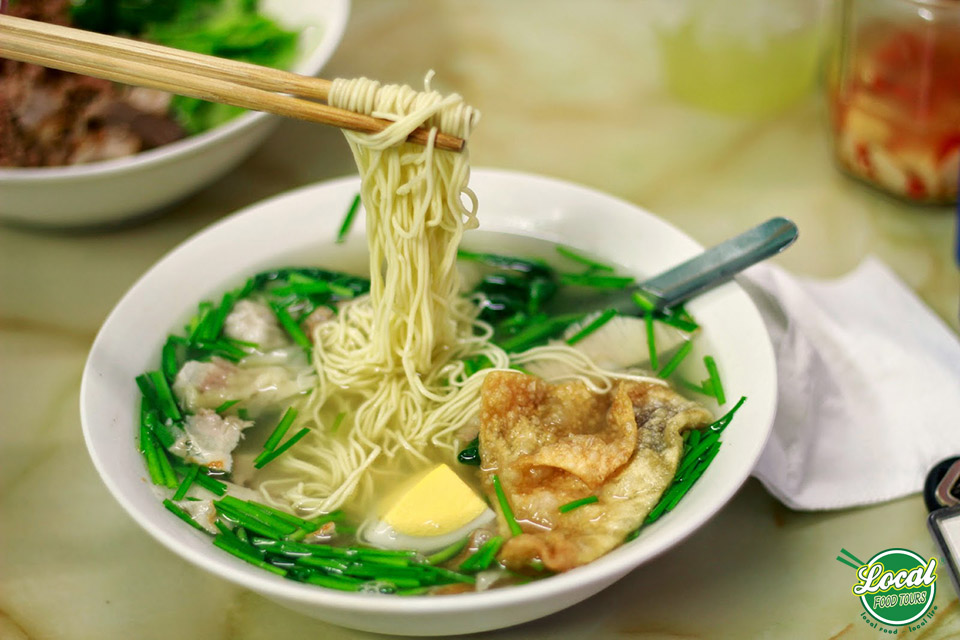Wonton noodle is not strange to the Hanoi street food devotees. As the noodles adopted from Guangzhou, China, wonton noodle soup has been in Vietnam for a long time and changed to satisfy the taste of Vietnamese. That makes many variants of wonton noodles in Vietnam as well as in Hanoi.

Traditional wonton noodles
It is called “traditional” because it is nearly the very first type of wonton noodles in Hanoi. This type of wonton noodles can also be seen everywhere if you join Vietnam food tours. In Hanoi, there are two famous wonton shops; they are on Mai Hac De Street and Hue Street. They were also the initial wonton shops in Hanoi.
In comparison with the wonton in the early 1990s, the wonton sold in the two shop today has some changes. Initially, traditional wonton only had shui jiao (also called sui cao in Vietnamese), char siu (barbecue pork spiced with soy sauce, hoisin sauce, five-spice powder… and tastes sweet), boiled egg, boiled pork liver and seasonal vegetables.
Until later, in the bowl of wonton, there are 2 or 3 pieces of fried shui jiao and dried pork skin. The fragrance and sweetness of traditional wonton come from dried shrimps rather than fresh shrimps.
Wonton with Fresh Shrimp
The appearance of this wonton type was affected by the “revolution” of protein supplement. At that time, bun oc (snail rice vermicelli soup) was added beef and bun rieu (crab paste rice vermicelli soup) was eaten with gio (Vietnamese sausages). So, people have eaten wonton noodles with fresh shrimp since then. Coincidentally, this added ingredients matches perfectly with wonton noodles.
If you attend Hanoi local food tours, you will find that many wonton shops have updated and listed this type of noodles in their menu. One of them is the shop on Thai Think Street. The small shop also has youtiao (Chinese cruller) which is extremely crispy and also a perfect match with the broth of wonton noodles.
Guangdong style wonton noodles
This is the type of wonton which is close to the original of Chinese noodles. The ingredients are the same as the types mentioned above; therefore, to distinguish this type from the others, people must pay attention to the odor. The characteristic odor of Guangdong wonton is the smell of garlic. Garlic is minced and mixed with the fillings of shui jiao; it is also deep fried. The noodles are thin and chewy, they are so attractive with greasy yellow.
If you join a food walking tour, don’t forget to stop by Tue Tinh Street to enjoy Guangdong style wonton noodles.
Dry wonton noodles
This type of wonton noodles was born at the same time as many other types of dry noodles like cellophane noodles, crab red rice noodles… Dinh Liet Street and Cau Go Street were the first places to sell this type of wonton. The seller server the noodles with all the ingredients of the traditional wonton; however, the noodles do not bath in broth but they are mixed with the special sauce which tastes nice with the light savory. The sauce is the secret of the shop owners.
Dry wonton noodles are served with a bowl of soup and some balls of shui jiao.
Although it was an imported dish, wonton noodles have developed and transformed to be warmly welcomed in Hanoi.

